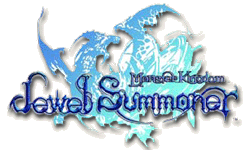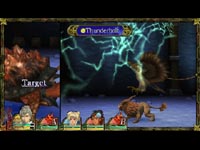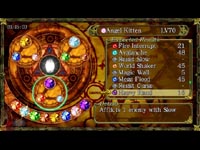|
|

|
BATTLE SYSTEM
|

|
INTERACTION
|

|
ORIGINALITY
|

|
STORY
|

|
MUSIC & SOUND
|

|
VISUALS
|

|
CHALLENGE
|
Easy
|
COMPLETION TIME
|
35 hours
|
|
OVERALL
2.0/5
|
Rating definitions
|
|
|
Kouji Okada, renowned father of the Shin Megami Tensei series, created Monster Kindgom: Jewel Summoner to evolve the fans of monster battling. Instead of the hero taking off on his own adventure with little guidance, our hero starts out with more questions than answers. Searching for these answers is just the beginning of a plot that could change the world as he knows it.
The hero of the story, Vice, is a monster hunter seeking the monster that slew his mother. He doesn't know much about the monster, just that it has wings. He travels the world, taking jobs hunting down monsters, including troublesome Abominations, hoping to find the one he's truly looking for. After finishing his current job, the elder of the village that hired him tells him about the Order, which is often hired to fight Abominations and would have a great deal of information about them. Vice heeds the advice of the elder and heads off to the Order. Since Vice can summon without proper training, the Order has interest in him as well. He reluctantly joins the ranks of the Order and is accompanied by two others almost immediately.
Vice must select two of the four available trainees from the Order, but is only able to find out a little bit of background information about each. Bargus is a polite gentleman, more mature than the others. Lynn is from an isolated island in the South. Elycia is a conceited young woman intent on making herself look good. She refers to herself in the third person as "Elly." Grey is an impatient, headstrong noble from the capital city, who never accepts assistance, even if he really needs it. Due to past history, that isn't explained, certain team members will refuse to work with certain others. The two that are not selected will form a team with the star pupil, Skipper. These two teams will be assigned different missions, but occasionally work on the same mission when the Order considers the job large enough. The two teams are sent to travel the world, seeking answers to mysteries the Order wants resolved. Why are monsters trapped in jewels? What really happened after the Great Disaster so many years ago? Each character also has their own questions they need answers to. The story is the most satisfying aspect of the entire game.
Each character carries up to three jewels, and each contains a summonable monster. The top slot on the jewel menu for each character is the monster that is summoned into battle. If a new monster is summoned during battle, either by the player or circumstances, that is the new default monster until changed again. These jewels can be swapped from character to character anywhere in the world. In order to change these nine with other reserves, the party must travel to the Order and access the Jewel Bank. The only exception to this is when a new monster is captured. The party has the option to swap out a currently equipped jewel for the new one. If so, the swapped jewel is stored in the Jewel Bank instead.
 Thunderbolt attack!
Thunderbolt attack!
|
|
The battles are entirely monster on monster. The character's Life Points (LP) are used for any monster summoned, so if a monster is defeated, the summoner is out of the battle. The monsters use abilities, spending Job Points (JP) doing so. When a monster runs out of JP, it returns to the jewel and the next monster takes its place automatically. Monsters regain JP as the party walks around. All LP and JP are restored to full by leaving a dungeon, or by touching a save point. All monsters are based off an element. There are eight elements in all: fire; water; thunder; earth; wind; ice; light; dark. These elements are divided into light (fire; thunder; wind) and dark (water; earth; ice). If a monster of one of the four light elements is hit with any of the four dark-based elements, it can be delayed from its next action. If this happens enough, the monster will become enraged and will no longer be able to be delayed. It will also have higher offense when its turn comes. Manipulating this is the heart of the battle system. Each element also has a weakness to another element. For example, ice is weak to fire and fire is weak to water. Light and dark are each other's weakness. Striking a monster with an element it's weak to not only delays it significantly, but does much more damage. However, this will almost guarantee the monster becomes enraged. It also has a chance to induce a status effect, but these are infrequent and aren't a point of concern.
Once a monster is weakened, it will visably droop. This is when it is most likely to be captured. Unfortunately, the only way to catch it is by using a prism of the same element as the monster and hope the monster is captured. The only way to gather prisms is by finding them in chests or drops from monsters of that element. Water and dark prisms are exceptionally rare, making it hard to create a balanced party of light and dark monsters. On occasion, if excessive damage is dealt to a monster, it will flash "Reverted" and freed from evil control. This the same as an automatic capture without using an item, but don't expect it to happen without some planning, and even then it's still a random chance.
While one way to enhance monsters is by fighting for experience points, Monster Kingdom: Jewel Summoner also has an equally important system of growth called Amalgamy. The monster lives inside a jewel, and with the help of one of the two Jewel Meisters, Jerro or Mikaela, the jewel can be altered and enhanced. The main process is to fuse elemental minerals, or quartz, to the jewel. Different elemental combinations allow abilities outside of normal growth to be given to a monster. The sheer number of quartz infused with a jewel can invoke other changes. A monster starts with four ability slots, but by fusing over a dozen quartz to the jewel, a fifth slot can be made. A certain number of a specific element will allow an evolution in many of the jewels. Some jewels can evolve multiple times. Jerro is more experienced and can do the fusion twice as fast as Mikaela, but can and does fail more often. Mikaela almost never fails the fusions. Failing the fusion attempt leaves the monster with the previous abilities, but the quartz count remains. This is helpful, at least, for reaching evolutions and more advanced abilities. These amalgamy processes take time. The fusions will run in real time, even when the game is off. The professor suggests setting up a more complex fusion before bedtime, as it could take all night to complete. The current abilities and stats of the monster, including experience points, can also be increased instantly by spending points earned in battles. There is a limit to how much enhancement can be done, but maxing out this type of enhancement is a luxury until near the end of the game when these points are easily obtainable.
 Begin the transformation
Begin the transformation
|
|
If it sounds complex, it is. A lot of time and money can be spent trying to make the perfect collection of monsters. However, near the end, the game awards the party a special monster that can deal damage against both the light and dark monsters. With a simple use of amalgamy enhancement, this monster can wipe the floor with anything that opposes it. It's also the only monster that excels in offensive and defensive stats. Since it's awarded by the story, and not a rare monster hard to obtain, the entire balance of the game is thwarted in one quick turn of events. How this will affect battles in multiplayer mode is unclear since the multiplayer feature was not testable before release, but expect everyone to have this monster on the front lines.
Another unusual aspect to the difficulty of the game, or lack thereof, is that the cap of the monsters in the party always greatly exceeds the monsters in any given dungeon. By sticking with a small core of monsters with higher levels, the player shouldn't have to worry about coming close to losing a battle, or even to the bosses.
At least the battles are great to look at. The developers took great care to make the monsters look realistic. Evolved forms of monsters are more than a palette change. They are larger, more detailed and can employ different stances. The patterns on the monsters look slick, and the small motions in battle are smooth. The effects are a bit small, but the elements are well represented. The only real flaw in how battles look is how the damage displays. When damage is dealt, two numbers are shown. One is the actual damage, and one is a percentage. This percentage is supposed to relate to the effectiveness of an attack, but it's unclear what 100% represents. A physical attack will always register 100% regardless of if it's a normal or weak strike, but an elemental attack can be significantly less than 100% and still deal more damage. When using an attack that hits multiple enemies, the camera zooms out to show damage to all and these numbers may jockey for display position, bouncing around the screen. There's also no check to see if the number is still visible, so it can settle out of view.
Outside of battle, Vice's model navigates the dungeons in typical overhead style. There's no camera control and the view angle doesn't change. It's easy to navigate without problems. Throughout the game, the party will gain Field Abilities that will allow them to unlock more and more in each dungeon. Abilities might include removing blocks to open paths, floating over small gaps, or lighting up darkened rooms. The use of these abilities is vital to the navigation of the dungeons, as each one is more complex. Some of the puzzles take just testing these abilities in multiple places, hoping for an opening.
 Professor Anhj awaits you at the Order
Professor Anhj awaits you at the Order
|
|
Outside of the dungeons, there's an overworld map. Each town is a blue dot and each dungeon is a red dot. Traveling to a town opens a picture of the town with another assortment of dots. Yellow dots are the shop for the town; the blue dots are various points of interest; and the green dot leads back to the world map. Once a point is selected, a new background of the area appears. If there's anyone to talk to, they can be selected. All dialogue shows a two-dimensional image of the character, and two can be shown at once to show conversation. There's a lot of swapping of these images when the story has scenes with multiple people, but it's never confusing. Some of the dialogue is repetitive, especially when all the characters gather together, but it helps tell a great story. Characters' images also change to express different moods and stances, and their mouths mostly synch with the voices. While the images display a fairly limited set of emotions, the voices bring the characters' feelings to light with ease.
Monster Kingdom: Jewel Summoner is a musical collection from a variety of well known talent. Aritsts for this title include Hitoshi Sakimoto, Yasunori Mitsuda, Masaharu Iwata, and Yoko Shimomura. Each town and dungeon has its own unique background music. Certain characters also have their own well-fitting theme music whenever they appear. The music excels in its purpose, to bring mood and feeling to the scenes. It takes full advantage of the sound the PSP can create. The sounds of the monster battles are very crisp. Each monster has its own sounds upon being summoned, attacking, or defeated. When the party monster takes damage, it's the character that reacts with a grunt, the same way every single hit no matter how hard. Before and after each battle, the characters quip about the difficulty of the battle. The preceding evaluation is often inaccurate, based on the relative level of monsters compared to other battles, instead of the level of the party's monsters. This is mostly apparent in every battle where the party comes upon less than three monsters. The party will always proclaim this will be a difficult fight.
The real flaw in this game is the unmanaged loading. While load times may be expected in all disc-based games, in this one, the developers opted to have the game load items only when they are called. The result is abysmal, bringing the enjoyment of gameplay to a grinding halt. The game randomly pauses for loading in the middle of dialogue, battle sequences, dungeon navigation, and other points of interruption. It's highly distracting. Loading of battle actions could've occurred during the player's selection, since there are only five possible choices. Overall, it would've been better to deal with one or two second delays for loading than disjointed gameplay.
The developers wanted to make a more mature, story heavy monster collecting game, and in that quest, they succeeded. Monster Kingdom: Jewel Summoner lays down the foundation for a solid game, but fails when it came to creating an enjoyable experience, leaving the player wondering what could have been. An absorbing story combined with excellent monster battle and growth systems make a grand start, but eventually the story becomes the only reason to continue through this game. Sadly, a good story alone can't save this game from its own execution.
Review Archives
|









